Kalākaua
| Kalākaua | |||||
|---|---|---|---|---|---|
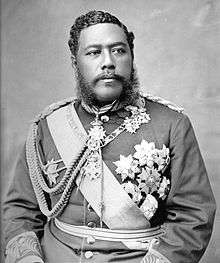 | |||||
| King of the Hawaiian Islands (more ...) | |||||
| Reign | February 13, 1874 — January 20, 1891 | ||||
| Investiture Coronation |
February 13, 1874, Kīnaʻu Hale February 12, 1883, ʻIolani Palace, Honolulu. | ||||
| Predecessor | Lunalilo | ||||
| Successor | Liliʻuokalani | ||||
| Born |
November 16, 1836 Honolulu, Oahu, Kingdom of Hawai'i | ||||
| Died |
January 20, 1891 (aged 54) Palace Hotel, San Francisco, California, United States of America | ||||
| Burial |
February 15, 1891[1] Mauna ʻAla Royal Mausoleum | ||||
| Spouse | Kapiʻolani | ||||
| |||||
| House | House of Kalākaua | ||||
| Father | Caesar Kapaʻakea | ||||
| Mother | Analea Keohokālole | ||||
| Religion | Church of Hawaii, Protestant Episcopal | ||||
| Signature |
| ||||
Kalākaua (November 16, 1836 – January 20, 1891), born David Laʻamea Kamananakapu Mahinulani Naloiaehuokalani Lumialani Kalākaua and sometimes called The Merrie Monarch, was the last reigning king of the Kingdom of Hawaiʻi. He reigned from February 12, 1874 until his death in San Francisco, California, on January 20, 1891.
During his reign hula was revived, after having been banned in 1830 by Queen Ka'ahumanu, who had converted to Christianity. He is also known for having revived surfing and the Hawaiian martial art, Kapu Kuialua.
Kalākaua and his brother and sisters were known as the "Royal Fours" for their musical talents. He wrote "Hawaiʻi Ponoʻī", which is the state song of Hawaii today. His ardent support of the then newly introduced ukulele as a Hawaiian instrument led to its becoming symbolic of Hawaii and Hawaiian culture. He is honored as "Patron of Hawaiian Music Culture" by the Hawaiian Music Hall of Fame[2] and was inducted into the Ukulele Hall of Fame in 1997.[3]
Early life
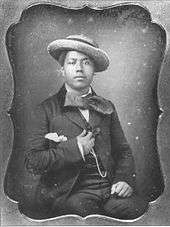
Kalākaua was the second surviving son of his father High Chief Caesar Kaluaiku Kapaʻakea and his mother High Chiefess Analea Keohokālole. He was the brother of James Kaliokalani, Lydia Kamakaʻeha, Anna Kaʻiulani, Kaʻiminaʻauao, Miriam Likelike, and William Pitt Leleiohoku II. His name Kalākaua translates into "The Day [of] Battle" and refers to the unequal treaty imposed by British Captain Lord Edward Russell of the Actaeon on Kamehameha III on the day of his birth.[4][5] Although he was promised in hānai (informal adoption) to Kuini Liliha, Kaʻahumanu II gave him to the High Chiefess Haʻaheo Kaniu and her husband Keaweamahi Kinimaka instead.[6]
When Haʻaheo died in 1843 she bequeathed all her properties to him.[7] His guardianship was entrusted in his hānai father, who was a chief of lesser rank; he took Kalākaua to live in Lāhainā. Kinimaka would later marry Pai, a subordinate Tahitian chiefess, who treated Kalākaua as her own until the birth of her own son.[6][8]
At the age of four, Kalākaua returned to Oʻahu to live with his biological parents and to begin his education at the Chiefs' Children's School. At the school, Kalākaua became fluent in English and the Hawaiian language. He began studying law at the age of 16. His various government positions, however, prevented him from fully completing his legal training. Instead, by 1856, the young Hawaiian was a major on the staff of King Kamehameha IV. He had also led a political organization known as the Young Hawaiians; the group's motto was "Hawaii for the Hawaiians." In addition to his military duties, Kalākaua served in the Department of the Interior and, in 1863, was appointed postmaster general. On December 8, 1863, Kalākaua married Kapiʻolani in a quiet ceremony conducted by an Episcopal minister. The timing of the wedding was heavily criticized since it fell during the mourning period for King Kamehameha IV.[9]
1872 election
King Kamehameha V, the last monarch of the Kamehameha dynasty, died on December 12, 1872 without naming a successor to the throne. Under the kingdom's constitution, if the king did not appoint a successor, a new king would be appointed by the legislature.
There were several candidates for the Hawaiian throne. However, the contest was centered on the two high-ranking aliʻi, or chiefs: William C. Lunalilo and Kalākaua. Lunalilo was more popular, partially because he was a higher-ranking chief than Kalākaua and was the immediate cousin of the Kamehameha V. Lunalilo was also the more liberal of the two—he promised to amend the constitution to give the people a greater voice in the government. Many believed that the government should simply declare Lunalilo as the king. Lunalilo, however, refused to allow this to be done and insisted that everyone in the kingdom should take part in an election for the office of the king.
Kalākaua published a proclamation written in a Hawaiian poetic style. Here is an excerpt:
O my people! My countrymen of old! Arise! This is the voice!Ho! all ye tribes! Ho! my own ancient people! The people who took hold and built up the Kingdom of Kamehameha. Arise! This is the voice. Let me direct you, my people! Do nothing contrary to the law or against the peace of the Kingdom. Do not go and vote. Do not be led by the foreigners; they had no part in our hardships, in gaining the country. Do not be led by their false teachings.
Kalākaua was much more conservative than his opponent, Lunalilo. At the time, foreigners dominated the Hawaiian government. Kalākaua promised to put native Hawaiians back into the kingdom's government. He also promised to amend the kingdom's constitution.
On January 1, 1873, a popular election was held for the office of King of Hawaii. Lunalilo won with an overwhelming majority. The next day, the legislature confirmed the popular vote and elected Lunalilo unanimously. Kalākaua conceded.
Reign as King
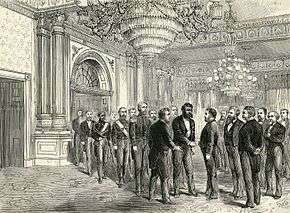
Lunalilo died on February 3, 1874, and Kalākaua was elected to replace him, supported by the legislature although many of the populace, mainly the native Hawaiian and British subjects in the kingdom, preferred Queen Dowager Emma, who stood against him. His election provoked the Honolulu Courthouse riots in which supporters of Queen Emma targeted legislators who supported Kalākaua; thirteen legislators were injured, with J. W. Lonoaea the only one to die from his injuries.[10]
Upon ascending the throne, Kalākaua named his brother, William Pitt Leleiohoku, as his heir.
Kalākaua began his reign with a tour of the Hawaiian islands. This improved his popularity. In December 1874, Kalākaua sent representatives to the United States to negotiate a reciprocity treaty to help end a depression that was ongoing in Hawaiʻi. In November, Kalākaua traveled to Washington, D.C. to meet President Ulysses S. Grant. An agreement was reached and the treaty was signed on January 30, 1875. The treaty allowed certain Hawaiian goods, mainly sugar and rice, to be admitted into the United States tax-free.
During the early part of Kalākaua's reign, the king made full use of his power to appoint and dismiss cabinets. King Kalākaua believed in the hereditary right of the aliʻi to rule. Kalākaua continually dismissed cabinets and appointed new ones. This drew criticism from people of the "Missionary Party" who wanted to reform Hawaiian government based on the model of the United Kingdom's constitutional monarchy where the monarch had very little real power over the government but had a position of great dignity and was the head of state. The party believed the legislature should control the cabinet ministers rather than the king. This struggle continued throughout Kalākaua's reign.

In 1881, King Kalākaua left Hawaiʻi and became the first monarch in the world, to venture on a trip around the world to study the matter of immigration and to improve foreign relations. He also wanted to study how other rulers ruled. In his absence, his sister and heir, Princess Liliʻuokalani, ruled as regent (Prince Leleiohoku, the former heir, had died in 1877). The king first traveled to San Francisco where he was given a royal welcome. Then he sailed to the Empire of Japan where he met with the Meiji Emperor. He continued through Qing Dynasty China, the Sultanate of Johore, Siam under King Chulalongkorn (Rama V), Burma, British Raj India, Egypt, Italy, Belgium, the German Empire, Austria-Hungary, the French Third Republic, Spain, Portugal, the United Kingdom of Great Britain and Ireland, and back through the United States before returning to Hawaiʻi.
During this trip, he met with many other crowned heads of state, including Pope Leo XIII, Umberto I of Italy, Abu Bakar of Johor, Tewfik, Viceroy of Egypt, William I of Germany, Rama V of Siam, U.S. President Chester A. Arthur, and Queen Victoria. In this, he became the first king to travel around the world.[11] William N. Armstrong, who was a member of the King's Cabinet and accompanied His Majesty on the circumnavigation,[12] documented the trip in Around the World With a King.[13] In the Kingdom of Sweden he was presented with the Royal Order of Vasa, Grand Cross, on 18 February 1881 by King Oscar II.[14]
Kalākaua also built ʻIolani Palace, the only royal palace that exists on American soil today, at a cost of $300,000—a sum unheard of at the time. Many of the furnishings in the palace were ordered by Kalākaua while he was in Europe.
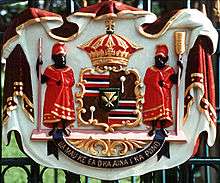
Kalākaua decided to erect the Kamehameha Statue in recognition of Kamehameha I, the first king of the whole Hawaiian Islands. The original statue was lost when the ship carrying it sank near the Falkland Islands, so a replacement was ordered and unveiled by the king in 1883. The original statue was later salvaged, repaired and sent to Hawaii in 1912. A third statue was erected in 1969 and is currently the only statue in the United States Capitol that commemorates a native Hawaiian.
King Kalākaua is said to have wanted to build a Polynesian Empire. In 1886, legislature granted the government $30,000 ($791,000 today) for the formation of a Polynesian confederation. The king sent representatives to Sāmoa, where Malietoa Laupepa agreed to a confederation between the two kingdoms. This confederation did not last very long, however, since King Kalākaua lost power the next year to the Bayonet Constitution, and thus a reformist party came into power that ended the alliance.
By 1887, the Missionary party had grown very frustrated with Kalākaua. They blamed him for the kingdom's growing debt and accused him of being a spendthrift. Some foreigners wanted to force King Kalākaua to abdicate and put his sister Liliʻuokalani onto the throne, while others wanted to end the monarchy altogether and annex the islands to the United States. The people who favored annexation formed a group called the Hawaiian League. In 1887, members of the league, armed with guns, assembled together. The members of the league forced him at gunpoint to sign the new constitution.

This new constitution, nicknamed the Bayonet Constitution of 1887, removed much of the king's executive power and deprived most native Hawaiians of their voting rights. 75% of ethnic Hawaiians could not vote at all, because of the gender, literacy, property, and age requirements.
With the new requirements, ethnic Hawaiians now amounted to about two-thirds of the electorate for representatives and about one-third of the electorate for Nobles. The rest of the voters were male residents of European or American ancestry.
While historically voting rights were not granted to all citizens in the kingdom, not unlike other countries at the time, the new constitution served to greatly disenfranchise the native Hawaiians and consolidated a major power shift. It even inserted a provision that allowed non-Hawaiian citizens to vote. Moreover, the legislature was now able to override a veto by the king, and the king was no longer allowed to take action without approval of the cabinet. The House of Nobles, the house of legislature appointed by the king, was to be elected.
A counter-revolution, led by Robert Wilcox, aimed at restoring the king's power. It failed.
Later years and death
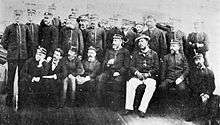
[15] On November 25, 1890, Mōʻī (King) Kalākaua visited California aboard the U.S.S. Charleston[16] with business between the Kingdom of Hawaii and the US Government.[17] Kalākaua, whose health had been declining, stayed in a suite at the Palace Hotel.[17][18] Traveling throughout Mexico and Southern California and reportedly drinking excessively, the monarch suffered a stroke in Santa Barbara[19] and was rushed back to San Francisco. Kalākaua fell into a coma in his suite on January 18 and died two days later on January 20, 1891. The official cause of death, listed by US Navy officials was that the king had died from Bright's Disease (inflammation of the kidneys).[17][20][21]
His final words were, "Aue, he kanaka au, eia i loko o ke kukonukonu o ka maʻi!," or "Alas, I am a man who is seriously ill." The more popular quote, "Tell my people I tried," attributed as his last words, was actually invented by novelist Eugene Burns in his 1952 biography of Kalākaua, The Last King of Paradise.[22] Shortly before his death his voice was recorded on a phonograph cylinder, which is now in the Bernice P. Bishop Museum.[23]
His remains were returned to Honolulu aboard the American cruiser USS Charleston (C-2). Because he and his wife, Queen Kapiʻolani, did not have children, Kalākaua's sister, Liliʻuokalani, succeeded him to the Hawaiian throne.
Legacy

King Kalākaua earned the nickname "the Merrie Monarch," because of his love of joyful elements of life. During his reign, hula was revived, after having been banned in 1830 by Queen Ka'ahumanu after she had converted to Christianity. Today, his name lives on in the Merrie Monarch Festival, a hula festival named in his honor. He is also known to have revived the Hawaiian martial art of Lua, and surfing. He and his brother and sisters were known as the "Royal Fours" for their musical talents. He wrote "Hawaiʻi Ponoʻī," which is the state song of Hawaii today. King Kalākaua's ardent support of the then newly introduced ukulele as a Hawaiian instrument led to its becoming symbolic of Hawaii and Hawaiian culture.
In Waikīkī, "Kalākaua Avenue" the main avenue of Waikīkī, was named after Kalākaua.
In 2003, the historic former federal building was renamed the King David Kalakaua Building after being purchased by the state and renovated.[24]
A Hawaiian song about Kalākaua can be heard in the Disney movie Lilo & Stitch. It is heard when Lilo is introduced in the movie. The mele was written as a mele inoa, its original title being He Inoa No Kalakaua. On the Lilo & Stitch soundtrack, it was retitled as "He Mele No Lilo".
Ancestry
| Ancestors of Kalākaua | ||||||||||||||||||||||||||||||||||||||||||||||||||||||||||||||||||||||||||||||||||||||||||||||||||||||||||||||||||||||||||||||||||||||||||||||||||||||||||||||||||||||||||||||||||||||||||||||||||||||||||||||||||||||||||||||||||||||||||||||||||||||||||||||||||||||||||||||||||||||||||||||||||||||||||||||||||||||||||||||||||||||||||||||||||||||||||||||||||||||||||||||||||||||||||||||||||||||||||||||||||||||||||||||||||||||||||||||||||||||||||||||||||||||||||||||||||||||||||||||||||||||||||||||||||||||||||||||||||
|---|---|---|---|---|---|---|---|---|---|---|---|---|---|---|---|---|---|---|---|---|---|---|---|---|---|---|---|---|---|---|---|---|---|---|---|---|---|---|---|---|---|---|---|---|---|---|---|---|---|---|---|---|---|---|---|---|---|---|---|---|---|---|---|---|---|---|---|---|---|---|---|---|---|---|---|---|---|---|---|---|---|---|---|---|---|---|---|---|---|---|---|---|---|---|---|---|---|---|---|---|---|---|---|---|---|---|---|---|---|---|---|---|---|---|---|---|---|---|---|---|---|---|---|---|---|---|---|---|---|---|---|---|---|---|---|---|---|---|---|---|---|---|---|---|---|---|---|---|---|---|---|---|---|---|---|---|---|---|---|---|---|---|---|---|---|---|---|---|---|---|---|---|---|---|---|---|---|---|---|---|---|---|---|---|---|---|---|---|---|---|---|---|---|---|---|---|---|---|---|---|---|---|---|---|---|---|---|---|---|---|---|---|---|---|---|---|---|---|---|---|---|---|---|---|---|---|---|---|---|---|---|---|---|---|---|---|---|---|---|---|---|---|---|---|---|---|---|---|---|---|---|---|---|---|---|---|---|---|---|---|---|---|---|---|---|---|---|---|---|---|---|---|---|---|---|---|---|---|---|---|---|---|---|---|---|---|---|---|---|---|---|---|---|---|---|---|---|---|---|---|---|---|---|---|---|---|---|---|---|---|---|---|---|---|---|---|---|---|---|---|---|---|---|---|---|---|---|---|---|---|---|---|---|---|---|---|---|---|---|---|---|---|---|---|---|---|---|---|---|---|---|---|---|---|---|---|---|---|---|---|---|---|---|---|---|---|---|---|---|---|---|---|---|---|---|---|---|---|---|---|---|---|---|---|---|---|---|---|---|---|---|---|---|---|---|---|---|---|---|---|---|---|---|---|---|---|---|---|---|---|---|---|---|---|---|---|---|---|---|---|---|---|---|---|---|---|---|---|---|---|---|---|---|---|---|---|---|---|---|---|---|---|---|---|---|---|---|---|---|---|---|---|---|---|---|---|---|---|---|---|---|---|---|---|---|---|---|---|---|---|---|---|---|---|---|---|---|---|---|---|---|---|---|---|---|---|---|---|---|---|---|---|---|---|---|---|---|---|---|---|---|---|---|---|---|---|---|---|---|---|---|---|---|---|
| ||||||||||||||||||||||||||||||||||||||||||||||||||||||||||||||||||||||||||||||||||||||||||||||||||||||||||||||||||||||||||||||||||||||||||||||||||||||||||||||||||||||||||||||||||||||||||||||||||||||||||||||||||||||||||||||||||||||||||||||||||||||||||||||||||||||||||||||||||||||||||||||||||||||||||||||||||||||||||||||||||||||||||||||||||||||||||||||||||||||||||||||||||||||||||||||||||||||||||||||||||||||||||||||||||||||||||||||||||||||||||||||||||||||||||||||||||||||||||||||||||||||||||||||||||||||||||||||||||
References
- ↑ David W. Forbes, ed. (2003). Hawaiian national bibliography, 1780–1900. 4. University of Hawaii Press. p. 404. ISBN 0-8248-2636-1.
- ↑ "Patron of Hawaiian Music Culture: David Kalakaua (1836-1891)". Hawaiian Music Hall of Fame.
- ↑ "David Kalakaua (1836 - 1891): Inaugural Hall of Fame Inductee, 1997". Ukulele Hall of Fame Museum.
- ↑ Niklaus Rudolf Schweizer (2005). Turning tide: the ebb and flow of Hawaiian nationality. Peter Lang. p. 249. ISBN 0-8204-7030-9.
- ↑ Kingdom of Hawaii (1875). Treaties and conventions concluded between the Hawaiian Kingdom and other powers, since 1825. Pacific Commercial Advertiser Print. p. vii.
- 1 2 Darlene E. Kelley (January 1, 2001). "Kalakaua Part 2". Keepers of the Culture: A study in time of the Hawaiian Islands As told by the ancients. Retrieved January 28, 2010.
- ↑ Supreme Court of Hawaii (1866). Reports of a portion of the decisions rendered by the Supreme Court of the Hawaiian Islands in law, equity, admiralty, and probate. Govt. Press. pp. 82–86.
- ↑ Sheldon Dibble (1843). History of the Sandwich Islands. Lahainaluna: Press of the Mission Seminary. p. 330.
- ↑ Allen, Helena G. (1995). Kalakaua: Renaissance King. Honolulu: Mutual Publishing. p. 33. ISBN 978-1-56647-059-9.
- ↑ Dabagh, Jean; Lyons, Curtis Jere; Hitchcock, Harvey Rexford (1974). Dabagh, Jean, ed. "A King is Elected: One Hundred Years Ago" (PDF). Hawaiian Journal of History. 8: 76–89.
- ↑ Ka Momi. Huapala.org. Retrieved on 2011-07-28.
- ↑ William N. Armstrong (May 1995). "About the Author: William N. Armstrong (Hardcover edition)". Editorial Reviews (Mass Market Paperback ed.). Amazon.com. ISBN 1-56647-017-X.
- ↑ Armstrong, William N. and Grant, Glen (May 1995). Around the World With a King. Mutual Pub Co. ISBN 1-56647-017-X.
- ↑ Sveriges Statskalender 1882
- ↑ "Days Gone By: 1890: Hawaii's King Kalakaua visits San Francisco – The Mercury News". mercurynews.com. Retrieved 3 November 2016.
- ↑ All about Hawaii: The Recognized Book of Authentic Information on Hawaii, Combined with Thrum's Hawaiian Annual and Standard Guide. Honolulu Star-Bulletin. 1890. p. 1.
- 1 2 3 Stephen Dando-Collins (1 April 2014). Taking Hawaii: How Thirteen Honolulu Businessmen Overthrew the Queen of Hawaii in 1893, With a Bluff. Open Road Media. p. 38. ISBN 978-1-4976-1429-1.
- ↑ William Armstrong (13 December 2013). Around the World with a King. Tuttle Publishing. p. 22. ISBN 978-1-4629-1150-9.
- ↑ Ralph S. Kuykendall (1967). The Hawaiian Kingdom: 1874-1893, the Kalakaua dynasty. University of Hawaii Press. p. 472. ISBN 978-0-87022-433-1.
- ↑ Sarah Vowell (22 March 2011). Unfamiliar Fishes. Penguin Publishing Group. p. 91. ISBN 978-1-101-48645-0.
- ↑ Carl Nolte (22 August 2009). "S.F.'s (New) Palace Hotel Celebrates a Century". San Francisco Chronicle. Retrieved 2010-04-18.
- ↑ Thompson, David (February 2013). "Kalakaua's Famous Last Words?". Honolulu Magazine. PacificBasin Communications.
- ↑ Bishop Museum Tries To Revive Past King's Voice. Kitv.com (2009-11-24). Retrieved on 2011-07-28.
- ↑ Gordon Y.K. Pang (December 30, 2003). "Old post office assumes new role". Honolulu Advertiser. Retrieved October 21, 2010.
Further reading
- Girod, André (2014). American Gothic: Une mosaïque de personnalités américaines (in French). L'Harmattan. ISBN 978-2-343-04037-0.
- Tabrah, Ruth M. (1984). Hawaii: A History. W. W. Norton & Company. ISBN 0-393-30220-2.
- Tsai, Tiffany Lani Ing (2014). ""He Ka Waiho Hoʻohemahema": Kana Maoli Responses to King Kalakaua's Tour of the Kingdom from 1874 Newspapers in Hawaiʻi". Hawaiian Journal of History. Honolulu: Hawaiian Historical Society. 48: 115–143. hdl:10524/47258.
External links
| Wikimedia Commons has media related to Kalākaua. |
| Preceded by Lunalilo |
King of Hawaiʻi 1874–1891 |
Succeeded by Liliʻuokalani |